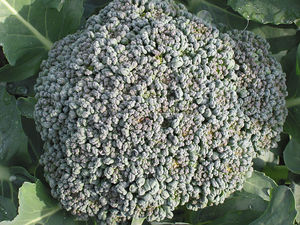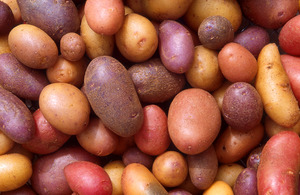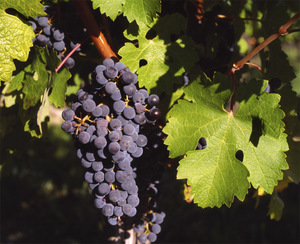Permaculture companion plants for Trifolium pratense
| Image | Name | Data | Description | Actions |
|---|---|---|---|---|

|
Broccoli |
2-11
Full sun, Partial sun/shade
Moist
Light (sandy), Medium, Heavy (clay)
6.0-7.0
0.9
Annual, Biennial
45cm
6-8 weeks before last frost
7-10 days
4°C (40°F)
50-100
3 to 7 years
Companion
true
Flowers, Leaves, Shoots
Brokkoli
Brassicaceae or Cruciferae
https://pfaf.org/User/Plant.aspx?LatinName=Brassica oleracea italica
|
Broccoli is a plant that is native to the Mediterranean region. It is part of the Brassica oleracea family, which also includes other vegetables such as cauliflower and cabbage. Broccoli plants have green, flowering heads that are similar in appearance to cauliflower. The stems are typically thick and can grow to be quite large, depending on the variety of broccoli. The leaves of the plant are typically dark green and are arranged in a spiral pattern along the stem. When it comes to growing conditions, broccoli prefers cool weather and well-draining soil. It is a relatively fast-growing plant, with the flowering heads typically forming in the first year. To cultivate broccoli successfully, a grower will need to make sure the plant gets enough water and sunlight, and provide it with the necessary nutrients through fertilization. In terms of winter hardiness, broccoli is not very frost-tolerant, so it is typically grown as a cool-season crop in areas with mild winters. In terms of edibility, broccoli is a very nutritious vegetable that is packed with vitamins and minerals. The flowering heads and the stems are both edible, and can be cooked in a variety of ways. After harvest, broccoli can be stored in the refrigerator for several days, or frozen for longer-term storage. ### Propagation - Direct sow Sow seeds 7cm apart, thin when seedlings reach 5-7cm in height. ### Propagation - Transplant Start seeds 6-8 weeks before your last frost date, or 2-3 weeks before last frost date. Plant outside when seedlings are 4-6 weeks old, or have 4-5 leaves. #### Links [Broccoli @ Almanac](https://www.almanac.com/plant/broccoli) |
Show
Edit |

|
Potato |
3-10
Full sun
Moist
Light (sandy), Medium, Heavy (clay)
1.0
0.5
Perennial
12 inches
Seed - direct sow
April
Root
Irish potato, Andigena
Kartoffel
Solanaceae
Argentina Northwest, Argentina South, Bolivia, Chile Central, Chile North, Chile South, Colombia, Ecuador, Peru, Venezuela
Assam, Bangladesh, Belgium, Dominican Republic, East European Russia, East Himalaya, France, Great Britain, Haiti, Hawaii, Illinois, India, Ireland, Laos, Maryland, Minnesota, New York, South European Russi, Tadzhikistan, Uzbekistan, Vietnam, Zaïre
https://en.wikipedia.org/wiki/Potato
https://pfaf.org/User/Plant.aspx?LatinName=Solanum tuberosum
https://powo.science.kew.org/taxon/urn:lsid:ipni.org:names:821337-1
Rutin
Alcohol, Biomass, Cleanser, Cosmetic, Polish, Starch
true
|
Potato (Solanum tuberosum) is a herbaceous perennial plant that is native to the Andean region of South America. It is a member of the nightshade family (Solanaceae) and is closely related to other nightshades such as tomatoes, eggplants, and bell peppers. The potato plant has a bushy growth habit and can grow to heights of 30-150 cm depending on the variety. The leaves are large, heart-shaped, and alternate along the stem. The flowers are white or purple and have five petals. The plant produces small green berries that contain numerous seeds, but most varieties of potatoes are propagated vegetatively from tubers rather than from seeds. The edible part of the potato plant is the tuber, which is an underground stem that is modified for food storage. Potatoes come in a wide range of shapes, sizes, and colors including white, yellow, red, and purple. The size and shape of the tuber depends on the variety, with some varieties producing small, round tubers and others producing large, elongated tubers. Potatoes grow best in well-draining, fertile soils in a sunny location with a pH of 4.5-6.0. They require regular watering and should be planted in a location with good air circulation to prevent fungal diseases. Potatoes are typically planted from tubers that have been treated with a fungicide to prevent disease and are spaced 25-30 cm apart in rows that are 75-90 cm apart. The tubers will begin to form in the soil around 6-8 weeks after planting and can be harvested when they reach the desired size. Potatoes are a versatile and nutritious food source that is rich in vitamins, minerals, and fiber. The tubers are eaten cooked, baked, fried, or mashed, and the leaves and flowers of the plant can also be eaten. Potatoes can be stored in a cool, dry, and dark place for several months. Potatoes have a number of uses beyond their value as a food source. The tubers can be used as seed potatoes for planting, and the leaves and stems can be used as a natural insecticide or as mulch in the garden. In some parts of the world, potatoes are also used for their medicinal properties. Potatoes are a valuable food source for a variety of wildlife, including deer, rabbits, and squirrels. The flowers of the potato plant are also a source of nectar for bees and other pollinators. |
Show
Edit |

|
Common Grape Vine |
6-10
Perennial
Full sun, Partial sun/shade
Dry, Moist
Light (sandy), Medium, Heavy (clay)
Deciduous
15-32m
Vines
True
Flowers, Fruit, Leaves, Seed
Seed - direct sow, Cuttings
https://en.wikipedia.org/wiki/Vitis_vinifera
Fast
Wine grape, Purpleleaf grape, Common grape, Angur, Diva loza, Grozde yagorida, Tumpeang ba'y chu, Uva, Vid, Vigne, Vino, Weinrebe, Aanab, Ainab, Aitoviiniköynnös, Lehti, Angoor, Angur, Blad från vinranka, Bortermo szolo levél, Cognac oil, Common grape vine, Dakh, Darakh, Drakh, Draksa, Draksh, Draksha, Draksha kottai, Draksha pondu, Drakshai, Drakya, Dry grapes, Drak?a (fruit), European grape, Feuille de vigne rouge, Folha de videira, Frunze de vita-de-vie, Gostani, Gostoni, Grape, Grape seeds oligomeric proanthocyanidins, Grape vine, Grapevine, Grapevine leaf, Kashmish, Kishmish, Kottai drakshai, Lambrusca, Lambrusque, Lie de vin, List vinica, List vinske trte, Lisc winorosli wlasciwej, Maneka, Maweez munaqqa, Maweezak kohi, Munaca, Munaqqa, Munkka, Munthringya, M?dvika, Parra, Raisins, Rote weinrebenblätter, Rød vinranke, Blad, Tikruju vynmedžiu lapai, Vid, Hoja de, Vigne, Vigne rouge, Vigne vinifère, Viinapuu lehed, Vinblad, Vine, Vinho, Vino, Vite, Foglia, Vitis vinifera, Flos, Vitis viniferae folium, Vínviðarlauf, Weinrebe, Werqa tad-dielja, Wijnstokblad, Wine, Wine grape, Zabeeb-ul-jabal, Cervený list vinné révy, Ista vinkoka lapas
Vitaceae
Weintraube
Oil
https://pfaf.org/user/plant.aspx?latinname=Vitis+Vinifera
Southern Europe, Central Europe, Southwestern asia , Albania, Austria, Bulgaria, Corse, Cyprus, Czechoslovakia, France, Germany, Greece, Hungary, Iran, Iraq, Italy, Kirgizstan, Krym, Lebanon-Syria, North Caucasus, Palestine, Romania, Sardegna, Sicilia, Switzerland, Tadzhikistan, Transcaucasus, Turkey, Turkey-in-Europe, Turkmenistan, Ukraine, Uzbekistan, Yugoslavia
4.3-8.6
Tap
0.6-6m
8feet
6 weeks
20°c (69°f)
12 months
False
Druif
Vindrue
Afghanistan, Algeria, Angola, Argentina Northeast, Azores, Baleares, Bangladesh, Belgium, British Columbia, California, Canary Is., Cape Verde, Caroline Is., Chad, China North-Central, China South-Central, China Southeast, East Aegean Is., East European Russia, East Himalaya, Easter Is., Ecuador, Eritrea, Ethiopia, Gulf of Guinea Is., Idaho, India, Kazakhstan, Korea, Kriti, Laos, Libya, Madeira, Massachusetts, Morocco, New Hampshire, New York, New Zealand North, Oregon, Pakistan, Pennsylvania, Peru, Poland, Portugal, South European Russi, Spain, Tibet, Trinidad-Tobago, Tunisia, Vietnam, Washington, West Himalaya
https://powo.science.kew.org/taxon/urn:lsid:ipni.org:names:30478388-2
1
|
This is the common grape which has a lot of varieties but only a few are grown (commercially). Common Grape Vine (Vitis vinifera) is a species of grapevine native to the Mediterranean region, central Europe, and southwestern Asia. It is a woody perennial vine that grows to a length of 20-30 feet when supported by a trellis or other structure. The leaves are dark green and palmately lobed, with five to nine leaflets. The flowers are small and greenish-white, and are produced in clusters. The fruit is a berry, typically blue or purple in color, and is edible. In terms of growth and cultivation, Common Grape Vine prefers full sun and well-draining soil. It can be grown from cuttings or from grape seeds, and should be trained to a trellis or other support structure. In order to produce fruit, the plant must be cross-pollinated with another grapevine of a different variety. The fruit is typically harvested in the late summer or early fall. The edible fruit of the Common Grape Vine can be eaten fresh or used to make wine, juice, and other products. The fruit can be stored by freezing or canning. The leaves can also be eaten, and are commonly used in dishes such as dolma. In addition to its edible fruit, the Common Grape Vine has several other uses. The leaves can be used as a source of natural dye, and the wood can be used for fuel or to make furniture and other items. The plant also provides habitat and food for a variety of wildlife, including birds and small mammals. Fruits are used to be eaten fresh or used for producing juice, wine or vinegar. Raisins are made out of dried grapes. Leaves and flowers can be eaten too. Seeds are used to produce oil. # Propagation While propagation from seed is possible, propagating from cuttings or grafting is way more common and simple. |
Show
Edit |